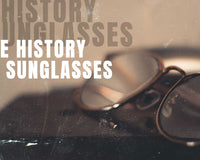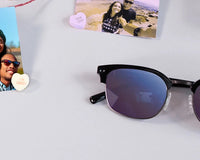
Sunglasses were originally invented to reduce distracting glare and allow more comfortable viewing in bright light. Early sunglasses were simply tinted glass or plastic lenses that were primarily meant to reduce brightness. Darker lenses were considered to be better because they screened out more light. As our understanding of the damaging nature of sunlight evolved, the need for better eye protection was recognized, and technology was developed to help sunglasses better screen out the harmful rays of the sun, especially UV rays.
In prehistoric and historic time, Inuit peoples wore flattened walrus ivory "glasses", looking through narrow slits to block harmful reflected rays of the Sun.
It is said that the Roman emperor Nero liked to watch gladiator fights using cut emeralds. These, however, appear to have worked rather like mirrors. Sunglasses made from flat panes of smoky quartz, which offered no corrective powers but did protect the eyes from glare, were used in China in the 12th century or possibly earlier. Ancient documents describe the use of such crystal sunglasses by judges in ancient Chinese courts to conceal their facial expressions while questioning witnesses.
James Ayscough began experimenting with tinted lenses in spectacles in the mid-18th century, around 1752. These were not "sunglasses" as that term is now used; Ayscough believed that blue- or green-tinted glass could correct for specific vision impairments. Protection from the Sun's rays was not a concern for him. One of the earliest surviving depictions of a person wearing sunglasses is of the scientist Antoine Lavoisier in 1772.

Inuit snow goggles function by reducing exposure to sunlight, not by reducing its intensity
In 1913, Crookes lenses were introduced, made from glass containing cerium, which block ultraviolet light. In the early 1920s, the use of sunglasses started to become more widespread, especially among movie stars. Inexpensive mass-produced sunglasses made from celluloid were first produced by Sam Foster in 1929. Foster found a ready market on the beaches of Atlantic City, New Jersey, where he began selling sunglasses under the name Foster Grant from a Woolworth on the Boardwalk. By 1938, Life magazine wrote of how sunglasses were a "new fad for wear on city streets ... a favorite affectation of thousands of women all over the U.S." It stated that 20 million sunglasses were sold in the United States in 1937, but estimated that only about 25% of American wearers needed them to protect their eyes. Polarized sunglasses first became available in 1936, when Edwin H. Land began experimenting with making lenses with his patented Polaroid filter. In 1947, the Armorlite Company began producing lenses with CR-39 resin.
At present, Xiamen, China, is the world's largest producer of sunglasses, with its port exporting 120 million pairs each year.

British chemist and physicist who attended the Royal College of Chemistry in London, and worked on spectroscopy.










